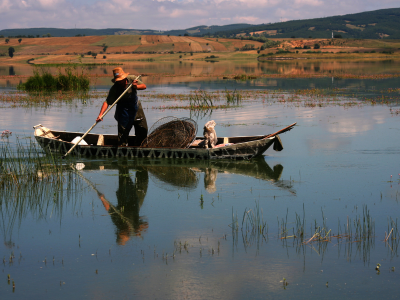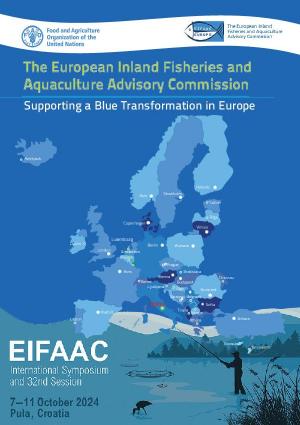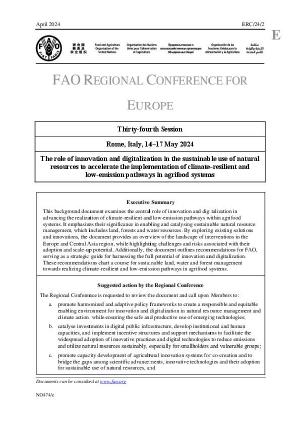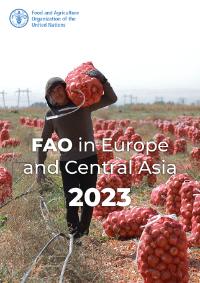
Europe and Central Asia Regional Overview of Food Security and Nutrition 2024
Managing water sustainably for improved food security and nutrition
This report provides the latest updates on hunger, food insecurity and malnutrition in Europe and Central Asia, including the cost and affordability of healthy diets. It also explores the central theme of water security, highlighting its critical connections to agriculture, food security and nutrition. While the region has made progress in reducing hunger and food insecurity (SDG Target 2.1), challenges remain in eliminating all forms of malnutrition (SDG Target 2.2).
Collections
- Country gender assessment series
- Digital agriculture
- Disaster risk reduction and management publication series
- Empowering smallholders and family farms series
- Transboundary animal diseases - Leaflets
Multimedia resources
Publications

Stories of agrifood systems change
07/2024
A series of country change stories has been documented in an attempt to ground the global agrifood systems discourse in specific realities and make sense of what they mean at country level. The five stories in this publication illustrate the varied ways in which FAO accompanied governments, civil society organizations and other development partners on a journey of agrifood systems transformation in Côte d’Ivoire, Cambodia, the Pacific, Guatemala and Albania.

Save food, save the planet!
06/2024
Food loss and waste (FLW) is a major global challenge, one that squanders precious resources and deepens the climate crisis through the production of greenhouse gas emissions. FLW also exacerbates global problems like poverty and hunger. Reducing FLW is therefore crucial for achieving a more sustainable and equitable agrifood system, which in turn will promote food security, strengthen food chains and minimize the environmental footprint of food systems.

Desk review of livestock-related emergencies and response in Eastern Europe and Central Asia
06/2024
This review covers three types of emergency: slow onset (such as drought); rapid onset (flooding, earthquakes, hurricanes, volcanic eruptions, tsunamis; and complex (mostly war or conflict-related). It considers natural disasters and protracted crises only and covers all of these categories of emergencies within Eastern Europe and Central Asia over the past 25 years, based on a set of crises prioritized by the FAO regional team (see Annex A for the list of countries and emergencies).
.jpg?sfvrsn=5f9ef71f_1)
Kosovo gender profile for agriculture and rural livelihoods
06/2024
The Kosovo gender profile for agriculture and rural livelihoods aims to improve knowledge on gender‑related issues in agriculture. It proposes evidence‑based recommendations for advancing gender equality.

Connected farmers: A casebook of good practices and inspiring stories from Europe and Central Asia
05/2024
This casebook unfolds the stories of 25 farmers and agripreneurs who have successfully embraced digital technologies. The accounts presented here reveal that, opportunities for innovation and resilience can be found. The case studies presented here, grouped into five distinct use cases, illustrate the transformative power of digitalization in agriculture, and serve as tangible examples of the successes and lessons learned on the path to sustainable development.

Ukraine: Emergency Response Plan, January–December 2024
05/2024
The war in Ukraine continues to compound the vulnerabilities of rural communities, especially those living near the frontline. Rural communities are increasingly becoming food aid beneficiaries and nearly one‑third of planned food aid beneficiaries under the 2024 Humanitarian Response Plan are rural people who traditionally produce their own food. In this context, the Food and Agriculture Organization of the United Nations (FAO) has developed the 2024 Emergency Response Plan (ERP).

The European Inland Fisheries and Aquaculture Advisory Commission – Supporting a Blue Transformation in Europe 2024
05/2024
This 2024 document of the European Inland Fisheries and Aquaculture Advisory Commission (EIFAAC) describes progress made by EIFAAC in 2023 and 2024 towards implementing its workplan and showcases news from EIFAAC Members, such as new policies, new legislation, new studies, and innovations in aquaculture and inland fisheries production and management.

Guide to mainstream gender in the FAO project cycle
04/2024
This is an updated version of the 2017 Guide to mainstreaming gender in the FAO project cycle. It provides project formulators with practical guidance and tools to implement the gender related requirements established in the different phases of the FAO project cycle, and to support the formulation of projects and programs that contribute to advancing gender equality and women’s empowerment in agrifood systems, as foreseen by FAO’s mandate.

Europe and Central Asia gender newsletter, May 2024 – Issue #14
05/2024
In this issue of the FAO Europe and Central Asia Gender Newsletter, we provide an overview of the latest stories, including the United Nations Regional Forum on Sustainable Development, International Women’s Day celebrations, the Country Gender Assessment workshop in Albania, and expert insights from Albania, Georgia and Türkiye.

The role of innovation and digitalization in the sustainable use of natural resources to accelerate the implementation of climate-resilient and low-emission pathways in agrifood systems - ERC 24/2
05/2024
This background document examines the central role of innovation and digitalization in advancing the realization of climate-resilient and low-emission pathways within agrifood systems. It emphasizes their significance in enabling and catalysing sustainable natural resource management, it outlines recommendations for FAO, serving as a strategic guide for harnessing the full potential of innovation and digitalization.

Digital Villages in Tajikistan
05/2024
The flyer details the activities that are ongoing as part of the digital Villages initiative in Tajikistan. Digital Villages enhance rural resilience and food security by providing farmers with digital tools for accessing inputs, market information, and alternative sales channels online.

Enhancing diets and resilience
04/2024
This report presents the results of a mixed-method rapid assessment that provides both indicative quantitative information and in-depth qualitative analysis on the household-level impacts of the Cash+ pilot. The aim of this study is to evaluate the impacts of the pilot on beneficiaries, in particular on their diets, agricultural activities, income generation and poverty reduction and its potential for poverty reduction through a scale up of similar support.

Integrated land use management systems in Uzbekistan – Part 2
03/2024
This report aims to describe and analyse the economic and business aspects of agroforestry implementation in Uzbekistan. This information is presented to enable the development of detailed and specific suggestions for land use contract development.
.jpg?sfvrsn=210cc7ff_1)
Europe and Central Asia Gender Newsletter
03/2024
Each issue of FAO Europe and Central Asia Gender Newsletter explores and discusses women’s and men’s experiences in agriculture and food security in the region. This issue reports on the latest developments in gender equality and women's empowerment through the celebration of the International Day of Rural Women in the region, the 43rd session of the European Commission on Agriculture, FAO activities and projects in the Western Balkans and regional workshops organised in Georgia and Türkiye.

FAO in Europe and Central Asia 2023
03/2024
FAO’s work globally and in the Europe and Central Asia region is guided by the FAO Strategic Framework 2022–2031, which articulates the Organization’s vision of a sustainable and food-secure world for all. With the Strategic Framework and the four betters as a lens, this report reviews and describes the project and the programme work of the Organization at the regional level and in each of the FAO programme countries of the region.

Science–Policy Interface in action #1
03/2024
The brochure delves into the critical interface between science and policy within the agrifood system, emphasizing its role in driving transformation, resilience, and food security. It highlights the importance of Science–Policy Interfaces (SPIs) in translating scientific discoveries into actionable policies and practices.
.jpg?sfvrsn=8c7fecdb_2)
Digital Villages In Europe and Central Asia
01/2024
The Digital Village Initiative aims to transform rural life in Europe and Central Asia by deploying digital technologies. This project focuses on three key objectives: deliver increased agricultural productivity by introducing advanced technologies to farmers; connect rural communities through digital platforms that enhance access to essential services, and foster sustainable and resilient rural economies for long-term growth and prosperity.

Small ruminant value chains in Western Balkan countries
01/2024
The report delineates four principal market channels for small ruminant milk and three for small ruminant meat that farmers utilize for product commercialization. Albanian small ruminant farmers predominantly focus on milk production, while their counterparts in Serbia, Montenegro, and Bosnia and Herzegovina are inclined towards meat production.

Measuring the state of food safety in Belgium with a food safety barometer
01/2024
This publication document discusses the development and implementation of a food safety barometer in Belgium. The purpose of the barometer is to measure the state of food safety in the country and enable evidence-informed risk management and policy decisions. The barometer consists of 30 indicators that cover various aspects of food safety from farm to fork.
055033316b184760ac1014117ea0254d.jpg?sfvrsn=a62a48e8_2)
Promoting sustainable and circular bioeconomy through agriculture practice in Eastern Europe and Central Asia
12/2023
This report presents an overview of concepts related to bioeconomy and the benefits of their implementation in agriculture and shares agriculture production trends, bioeconomy initiatives and sustainable agriculture approaches from throughout the Eastern Europe and Central Asia region.
